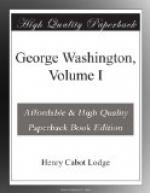In the north the winter was comparatively uneventful. The spring passed, and in June Clinton came out and took possession of Stony Point and Verplanck’s Point, and began to fortify them. It looked a little as if Clinton might intend to get control of the Hudson by slow approaches, fortifying, and then advancing until he reached West Point. With this in mind, Washington at once determined to check the British by striking sharply at one of their new posts. Having made up his mind, he sent for Wayne and asked him if he would storm Stony Point. Tradition says that Wayne replied, “I will storm hell, if you will plan it.” A true tradition, probably, in keeping with Wayne’s character, and pleasant to us to-day as showing with a vivid gleam of rough human speech the utter confidence of the army in their leader, that confidence which only a great soldier can inspire. So Washington planned, and Wayne stormed, and Stony Point fell. It was a gallant and brilliant feat of arms, one of the most brilliant of the war. Over five hundred prisoners were taken, the guns were carried off, and the works destroyed, leaving the British to begin afresh with a good deal of increased caution and respect. Not long after, Harry Lee stormed Paulus Hook with equal success, and the British were checked and arrested, if they intended any extensive movement. On the frontier, Sullivan, after some delays, did his work effectively, ravaging the Indian towns and reducing them to quiet, thus taking away another annoyance and danger.
In these various ways Clinton’s circle of activity was steadily narrowed, but it may be doubted whether he had any coherent plan. The principal occupation of the British was to send out marauding expeditions and cut off outlying parties. Tryon burned and pillaged in Connecticut, Matthews in Virginia, and others on a smaller scale elsewhere in New Jersey and New York. The blundering stupidity of this system of warfare was only equaled by its utter brutality. Houses were burned, peaceful villages went up in smoke, women and children were outraged, and soldiers were bayoneted after they had surrendered. These details of the Revolution are wellnigh forgotten now, but when the ear is wearied with talk about English generosity and love of fair play, it is well to turn back and study the exploits of Tryon, and it is not amiss in the same connection to recall that English budgets contained a special appropriation for scalping-knives, a delicate attention to the Tories and Indians who were burning and butchering on the frontier.




